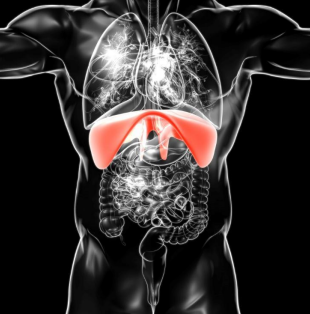Did you know that diaphragm injuries (diaphragmatic rupture) are a medical emergency?
● 911 should be called immediately.
● Prognosis is good if managed as soon as possible.
● Early death is often due to other injuries.
What is the diaphragm?
● The diaphragm is the arched, flat muscular structure that divides the thorax from the abdominal
cavity.
● The diaphragm plays a key role in respiration.
What is a diaphragm injury?
● A diaphragm injury or rupture is a tear to the diaphragm muscle across the bottom of the ribcage.
● Please note that this type of injury is rare.
● 80-90% of these injuries are caused by motor vehicle accidents.
● Other causes of diaphragm injuries are gunshots, stab wounds, falls, and crushing injuries.
● Major damage to the diaphragm will cause injuries to adjacent organs.
Negative affects of having a diaphragm injury
● Patients with large diaphragmatic defects have critical problems shortly after trauma as a result cardiorespiratory function associated with large herniation of abdominal contents to the pleural space.
● 64% to 87% of tears are commonly on the left side because the right side is of the diaphragm is well protected by the liver.
● Severe diaphragm ruptures caused by blunt or penetrating injuries can also present several years later with herniation, strangulation, and eventual rupture of abdominal viscera into the pleural cavity.
● These penetrating injuries may often be undiagnosed and overlooked in initial assessment because patients may be asymptomatic or have vague symptoms that may cause diagnosis to be delayed.
Signs and Symptoms of diaphragm injury
● Patients will show signs of decreased adequate ventilation and worsening respiratory function caused by herniation of abdominal organs into the chest cavity.
● Chest pains.
● Difficulty breathing [This is a medical emergency and 911 should be called immediately].
Treatment
● Diaphragm injuries are best managed by an interprofessional team that includes a cardiologist, a general surgeon, thoracic surgeon, and a trauma surgeon.
● Once diagnosed, the only treatment for a diaphragm tear is surgery.
● Diagnosis methods include chest X-rays, upper GI contrast study, fluoroscopic evaluation of diaphragmatic motion, ultrasound (US), computed topography (CT) scan, laparoscopy, and video-consisted thoracic surgery.

References
Lee K., Kashyap S., & Atherton, N.S. (2020). Diaphragm Injury.
https://www.ncbi.nlm.nih.gov/books/NBK482207/
Mybox. (2020). [Illustration]. Diaphragm Human Respiratory System Anatomy For Medical Concept 3D
Illustration.
https://www.shutterstock.com/image-illustration/diaphragm-human-respiratory-system-anatomy-medic
al-1849680343
Simon, L. V., Lopez, R. A., & Burns B. (2020). Diaphragm Rupture.
https://www.ncbi.nlm.nih.gov/books/NBK470214/
